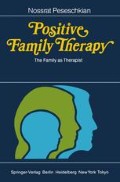Abstract
In the therapeutic situation, the positive process begins by looking at three aspects:
-
a)
Observation of the Patient’s Family and the Symptoms. This aspect allows for a diagnostic orientation based on these questions: Which personality and communication structures are present, and which differential diagnostic considerations are possible? What does the patient offer the therapist?
-
b)
Positive Interpretation of the Symptoms. We know that observation and the findings and diagnostic measures derived from it are not objective. Instead, the diagnostic relational systems of the therapist, his personal impressions, and the evaluations of the patient are also influential factors. In contrast to somatic medicine, this subjectivity is the crux of the matter in psycho- and family therapy. When we try other possibilities for evaluation (reinterpretation, positive interpretation, change of perspective), we do not do so because these might be objective. We do it as a way to relativise our own relational systems as well as those of the patient and his family. And we also want to initiate alternative solutions. We move away from the original symptoms and enter the areas where the patient feels he is “positive,” i.e., relatively free of symptoms, ego-strong, and resistant. Two aspects are involved in all this: the reinterpretation of the symptom and the attention paid to the patient’s capabilities.
-
c)
Reevaluation of the “Patient.” The patient’s role as his own therapist and the positive interpretation of the symptoms improve the patient’s position within the family (Schindler, R., 1976). The family structure thus takes on new importance as other members of the family are given the opportunity to step forward as patients. In this way, the family mechanisms for “sharing the illness” are revealed. It can thus be determined which family member ended up bearing the symptoms and how this happened.
One day’s happiness makes a man forget his misfortune, and one day’s misfortune makes him forget his past happiness.
—Ben Sirach,
Access this chapter
Tax calculation will be finalised at checkout
Purchases are for personal use only
Author information
Authors and Affiliations
Rights and permissions
Copyright information
© 1986 Springer-Verlag Berlin Heidelberg
About this chapter
Cite this chapter
Peseschkian, N. (1986). The Positive Procedure in the Therapeutic Process. In: Positive Family Therapy. Springer, Berlin, Heidelberg. https://doi.org/10.1007/978-3-642-70680-6_31
Download citation
DOI: https://doi.org/10.1007/978-3-642-70680-6_31
Publisher Name: Springer, Berlin, Heidelberg
Print ISBN: 978-3-540-15768-7
Online ISBN: 978-3-642-70680-6
eBook Packages: Springer Book Archive

